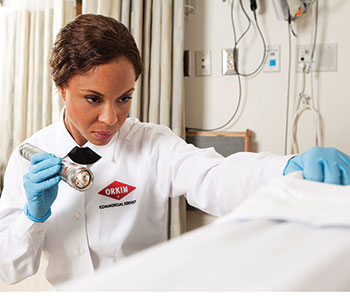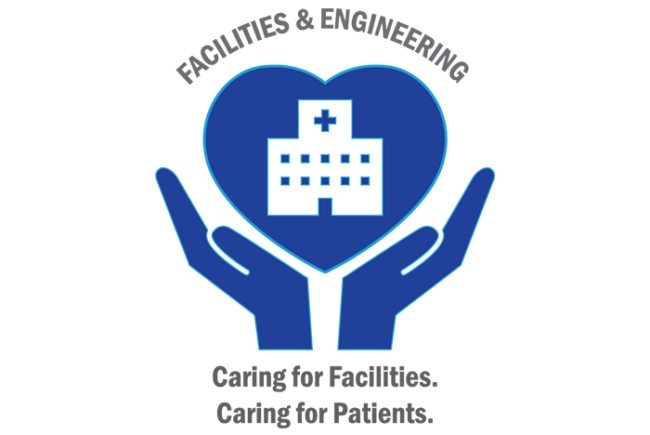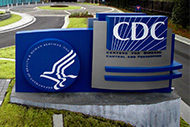 |
|
PHOTO COURTESY OF ORKIN LLC Bedbugs most often are found in patient room beds, waiting area furniture and laundry facilities. |
Health facilities professionals managing hospitals, long-term care facilities, emergency medical care centers and physical or mental rehabilitation facilities, face many challenges to ensure that they meet the highest level of sanitation while caring for sensitive populations.
Because pests pose a number of health threats through the spread of bacteria and contamination of surfaces, medical supplies and equipment, ensuring that the facility remains pest-free is one of these challenges.
As the size of a facility increases, so do the risk factors for pest infestations — larger kitchens, more food being served, more bathrooms and more visitors, among others. Other factors include the condition of the populations housed within the facilities and the organizational complexity of decision-makers.
The best way to prevent a pest problem is to understand how pests gain access, what pests are most problematic, where infestations are most likely to develop and how to prevent them.
Risks of entry
Health facility pest problems can occur because of pests that enter from the immediate surroundings; those that are within the structure; and those that are brought into the facility by visitors or staff via clothing, food, flowers or other items. While it may be difficult to stem the entry of pests by visitors, educating all staff about prevention within the facility can reduce problems.
First and foremost, facilities professionals must implement exclusion steps to stop pests from entering via the immediate surroundings. For example, facility entry doors should be closed at all times and should be designed to reduce or prevent entry of flying pests. Likewise, windows should be properly screened and utility openings properly closed off to prevent entry points.
Facilities professionals also should remember that colder weather tends to push many pests indoors, such as rodents. This typically occurs through utility openings or loading dock doors and via vegetation, such as shrubs or trees, planted close to buildings. Trimming landscaping can prevent rodents from having easy access to upper levels, windows and the roof.
A poorly maintained plumbing system also can easily attract such pests as cockroaches and flies seeking moisture. Any pipes with leaks or condensation can be problematic, as can clogged bathroom and kitchen drains. Fixing clogs, fastening floor drains and caulking any entry points around pipes can stop cockroaches, flies and rodents from using the plumbing system to spread throughout a facility.
Another easy access point for pests is via food deliveries. Thus, establishing protocols regarding the food flow throughout the facility is an essential component of an overall pest management program. For example, food service employees should inspect all food deliveries for actual pests or signs of pests, such as droppings or damaged packaging and food. Cardboard boxes in which food is delivered should be broken down and immediately discarded from the facility.
Additionally, stored food items should be kept on shelves off the floor and away from the walls. Kitchen staff should inspect such food items at least twice a month and report any signs of an infestation to facilities professionals. Additionally, kitchen staff should ensure that kitchen surfaces, and places under shelves and appliances are clean and free of food debris and moisture.
Finally, problematic pests like bedbugs can be transported on people’s clothing, in bags and purses, and through laundry collection. Educating laundry and housekeeping staff is especially important in spotting problems before a severe infestation takes root.
While these areas are at the highest risk of infestation inside health care facilities, the following areas also are considered hot spots and require vigilance: employee locker and break rooms, janitorial closets, laundry rooms, food service areas, restaurants, coffee and snack bars, vending machine areas, food carts, bedside furniture in patient rooms, floor drains and sink areas, intensive care wards, surgical suites, kidney dialysis rooms, autopsy rooms, trash dumpsters, loading docks and related spots.
Problematic pests
While there are many reasons why secondary infections can occur in health care facilities, common pests carry bacteria on their bodies, which can directly or indirectly impact patients either through personal contact or through contamination of equipment, supplies and surfaces in various parts of the facility.
The following pests present the highest health risks:
Cockroaches. Cockroaches spread nearly 33 different kinds of bacteria, six kinds of parasitic worms and at least seven other kinds of human pathogens. As vectors for disease, cockroaches often carry bacteria such as Escherichia coli and Salmonella on their bodies, which not only contaminate food, cooking equipment and food preparation surfaces, but also compromise the sterile environment of operating rooms and the cleanliness of exam rooms and patient rooms. Cockroaches also are responsible for increasing the severity of asthma and indoor allergy symptoms, especially in children and the elderly. Cockroaches are most likely to be found in locker and break rooms, laundry rooms, janitorial closets, food service areas, restaurants and snack bars, vending machine areas, food carts, floor drains and sink areas, intensive care units (ICUs), kidney dialysis and autopsy rooms as well as loading docks and garbage disposal areas.
Rodents. Rodents can enter buildings through almost any opening or crack larger than a dime. Once inside, rodents can cause structural damage as they are able to chew through wallboards, cardboard, wood and plaster and through electrical wiring, increasing the potential risk of fire. Additionally, rodents defecate constantly and can easily contaminate any and all food and food preparation surfaces. Facilities professionals must inspect for rodent droppings, especially in undisturbed areas like cafeteria pantries, storage areas and along walls. Rodents typically are found in laundry rooms, food service areas, food carts, loading docks and garbage disposal areas.
Ants. Ants are social insects. Therefore, spotting one ant indicates that many live within close quarters. While ants can contaminate food and food surfaces, the species of ant that is most worrisome in health care settings is the pharaoh ant. These ants can spread more than a dozen disease pathogens including Salmonella and Streptococcus pyogenes and are problematic because of their attraction to intravenous units, medical preparations and open wounds. Ants can be found in a wide range of laundry areas, ICUs, kidney dialysis and autopsy rooms.
Flies. Flies have been known to carry more than 100 different kinds of disease-causing germs. They contaminate food and surfaces by spreading disease organisms picked up on the silla on their bodies and through their saliva that is used to break down foods. They also defecate constantly. Keeping trash receptacles closed and as clean as possible, removing trash frequently and keeping food areas clean and free of food debris go a long way in keeping these filthy pests away. They can be found in almost every part of a health care facility, including food service areas, food carts, ICUs and surgical suites, autopsy rooms, laundry rooms, loading dock and garbage disposal areas.
Bedbugs. Bedbugs have made a serious comeback in the last two decades. A 2013 survey conducted by the National Pest Management Association and the University of Kentucky found that 33 percent of pest control professionals have treated for bedbugs in hospitals, while 46 percent did so in nursing homes. Although bedbugs are not considered vectors of disease, their bites can leave itchy, red welts and their presence can cause anxiety and sleeplessness. In some cases, patients also can experience a secondary infection caused by scratching at the bites and causing skin trauma, allowing for a port of entry for infection. Because bedbugs and their eggs hitchhike in bags, shoes and on people, they easily can be brought into a health care facility. Bedbugs most often are found in patient room beds, waiting area furniture, and laundry facilities.
Programs and education
Due to the complicated physical infrastructure and organizational complexity of health care facilities, the importance of educating all levels of staff and cooperation with an experienced pest management company should not be underestimated.
Programs that have the most success are those that have the full backing of every decision-maker in the facility and are in partnership with highly qualified and trained pest management professionals. Those professionals will work with the decision-makers to develop and implement an integrated pest management (IPM) program that is necessary for the sensitive populations housed within these facilities.
IPM involves commonsense solutions for treating and controlling pests. The focus is on finding the best treatment for a pest problem, not merely the simplest. Pest professionals utilize a three-part practice of inspection, identification and treatment. Treatment options in IPM can vary from sealing cracks to removing food and water sources to employing control products when necessary.
As part of IPM implementation, facilities professionals and administrators also must work with pest professionals to develop educational programs for facility staff. Because they are on-site every day, employees play an important role in keeping infestations in health care facilities at bay.
All staff should be educated on recognizing and reporting the presence of pests, no matter how miniscule a problem may seem. Whether it’s noticing rodent droppings or one cockroach in the kitchen, several ants in surgical or autopsy suites, a single bedbug or signs of one in a patient’s room or flies buzzing around garbage disposal areas — employees should recognize these as red flags for an underlying or potentially growing pest problem and report them immediately.
Not only should staff understand the prevention methods, but they also should have a basic understanding of pest behavior and biology as well, such as knowing that bedbugs hitchhike on personal belongings and cockroaches are attracted to moisture and hide in dark places.
Facilities professionals and administrators should work with pest management companies to develop printed materials that can be posted in employee break rooms and other areas where pests can get access, and distributed to staff as part of pest prevention educational efforts. They also should hold seminars or meetings at least twice a year to reinforce the staff’s role in maintaining a successful pest management program.
Proactive pest control
Pest prevention and management cannot be viewed as being unrelated to the overall safety and cleanliness of health care facilities. Rather, it must be viewed as critical to achieving these goals.
Establishing an effective professional pest management program is an investment in the health of patients and staff as well as an investment in maintaining a sound public reputation.
The benefits of a professional pest management program often far outweigh any associated costs and, in the long run, may save the facility valuable funds due to the proactive preventive measures put in place.
Jim Fredericks, Ph.D., is chief entomologist and vice president of technical and regulatory affairs, and Missy Henriksen is vice president of public affairs for the National Pest Management Association. They can be reached at jfredericks@pestworld.org and mhenriksen@pestworld.org.
Tips for health facilities professionals
A successful pest prevention effort involves every level of health care employee and every part of the facility. Some common tips gleaned from materials released by the National Pest Management Association and the Armed Forces Pest Management Board include the following:
• Find and eliminate sources of moisture in various plumbing areas, such as leaky pipes and clogged drains.
• Keep food sealed and stored properly, particularly in kitchens and cafeterias.
• Clean high-volume areas like public eating areas and kitchenettes, where crumbs, food scraps and trash are more likely to build up daily.
• Dispose of garbage regularly and store in sealed containers or dumpsters.
• Inspect food delivery boxes before storing in the kitchen.
• Keep storage areas dry and well-ventilated.
• Seal cracks and holes on the outside of the building, including entry points for utilities and pipes.
• Repair decaying exterior wood on buildings because some insects are drawn to deteriorating wood.
• Replace weather stripping and repair loose mortar around the foundation and lower-level windows.
• Look for rodent droppings in undisturbed areas, including closets and storage places.
• Trim or remove any vegetation, such as plants, shrubs and trees, and keep it at least two feet from the buildings.
• Regularly check for any kitchen drain clogs as well as under such appliances as refrigerators and freezers.
• Ensure that all entryways, especially in loading docks, are kept closed and never propped open.
• Use sodium vapor lights around the immediate exterior of the facility instead of fluorescent lights, which tend to attract flying insects. If fluorescent lights must be used, they should be mounted at least 100 feet from buildings.
Sources used in this article and their respective Web links are listed below:
• The National Pest Management Association — www.pestworld.org
• Armed Forces Pest Management Board's technical guide, "Pest Management Operations in Medical Treatment Facilities" — www.afpmb.org/sites/default/files/pubs/techguides/tg20.pdf





